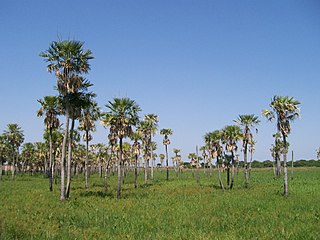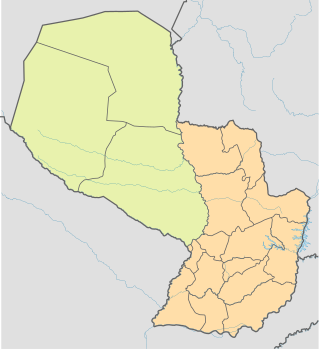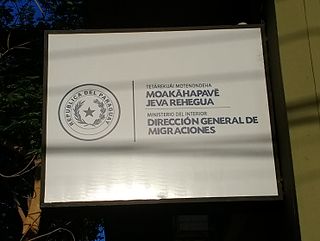Related Research Articles

Paraguay, officially the Republic of Paraguay, is a landlocked country in South America. It is bordered by Argentina to the south and southwest, Brazil to the east and northeast, and Bolivia to the northwest. It has a population of seven million, nearly three million of whom live in the capital and largest city of Asunción, and its surrounding metro. Although one of only two landlocked countries in South America, Paraguay has ports on the Paraguay and Paraná rivers that give exit to the Atlantic Ocean, through the Paraná-Paraguay Waterway.

Paraguay is a country in South America, bordering Brazil, Argentina and Bolivia. The Paraguay River divides the country into strikingly different eastern and western regions. Both the eastern region and the western region gently slope toward and are drained into the Paraguay River, which separates and unifies the two regions. With the Paraneña region reaching southward and the Chaco extending to the north, Paraguay straddles the Tropic of Capricorn and experiences both subtropical and tropical climates.

The Enxet are an indigenous people of about 17,000 living in the Gran Chaco region of western Paraguay. Originally hunter-gatherers, many are now forced to supplement their livelihood as laborers on the cattle ranches that have encroached upon their dwindling natural forest habitat. Nevertheless, the Enxet are still engaged in an ongoing conflict with the government and ranchers, who want to destroy what remains of the forest to open the land for massive settlement. Today, only a handful of Enxet are still able to maintain their traditional way of life, while the majority live in small settlements sponsored by various missionary organizations. The Enxet and Enlhet languages are still vigorous.

The Chaco War was fought from 1932 to 1935 between Bolivia and Paraguay, over the control of the northern part of the Gran Chaco region of South America, which was thought to be rich in oil. The war is also referred to as La Guerra de la Sed in literary circles since it was fought in the semi-arid Chaco. The bloodiest interstate military conflict fought in South America in the 20th century, it was fought between two of its poorest countries, both of which had lost territory to neighbours in 19th-century wars.

Chaco, officially the Province of Chaco, is one of the 23 provinces in Argentina. Its capital and largest city, is Resistencia. It is located in the north-east of the country.

The Gran Chaco or Dry Chaco is a sparsely populated, hot and semiarid lowland natural region of the Río de la Plata basin, divided among eastern Bolivia, western Paraguay, northern Argentina, and a portion of the Brazilian states of Mato Grosso and Mato Grosso do Sul, where it is connected with the Pantanal region. This land is sometimes called the Chaco Plain.

The Paraguayan Chaco or Región Occidental is a semi-arid region in Paraguay, with a very low population density. The area is being rapidly deforested. Consisting of more than 60% of Paraguay's land area, but with less than 10% of the population, the Chaco is one of the most sparsely inhabited areas in South America.

The indigenous Gran Chaco people consist of approximately thirty-five tribal groups in the Gran Chaco of South America. Because, like the Great Plains of North America, the terrain lent itself to a nomadic lifestyle, there is little to no archaeological evidence of their prehistoric occupation. Contributing to this near-absence of archaeological data is the lack of suitable raw material for stone tools or permanent construction and soil conditions that are not conducive to the preservation of organic material.

Guaycuru or Guaykuru is a generic term for several ethnic groups indigenous to the Gran Chaco region of South America, speaking related Guaicuruan languages. In the 16th century, the time of first contact with Spanish explorers and colonists, the Guaycuru people lived in the present-day countries of Argentina, Paraguay, Bolivia, and Brazil.

Estadio Defensores del Chaco is a multi-purpose stadium in Asunción, Paraguay. It is currently used mostly for football matches. The stadium once had a 50,000+ capacity, however over the years the stadium has undergone remodeling, dropping the capacity to 42,354. It underwent renovations during 1939, 1996 and 2007. The stadium was again renovated in 2015. It has more than 100 years as a stadium. It is one of the places with most history in Paraguayan football. In 1960, the stadium was the venue of the first final of the Copa Libertadores. The stadium receives visits from the public from Monday to Friday from 8:30 to 12:00 and 14:00 to 16:00 with free access.
Guaicuruan is a language family spoken in northern Argentina, western Paraguay, and Brazil. The speakers of the languages are often collectively called the Guaycuru peoples. For the most part, the Guaycuruans lived in the Gran Chaco and were nomadic and warlike, until finally subdued by the various countries of the region in the 19th century.

Mataguayo–Guaicuru, Mataco–Guaicuru or Macro-Waikurúan is a proposed language family consisting of the Mataguayan and Guaicuruan languages. Pedro Viegas Barros claims to have demonstrated it. These languages are spoken in Argentina, Brazil, Paraguay, and Bolivia.
The Mbayá or Mbyá are an indigenous people of South America which formerly ranged on both sides of the Paraguay River, on the north and northwestern Paraguay frontier, eastern Bolivia, and in the adjacent province of Mato Grosso do Sul, Brazil. They have also been called Caduveo. In the 16th century the Mbayá were called Guaycuru, a name later used generically for all the nomadic and semi-nomadic indigenous peoples of the Gran Chaco. The Kadiwéu people of Brazil are the surviving branch of the Mbayá.
Ayoreo is a Zamucoan language spoken in both Paraguay and Bolivia. It is also known as Morotoco, Moro, Ayoweo, Ayoré, and Pyeta Yovai. However, the name "Ayoreo" is more common in Bolivia, and "Morotoco" in Paraguay. It is spoken by Ayoreo, an indigenous ethnic group traditionally living on a combined hunter-gatherer and farming lifestyle.
The Mascoian also known as Enlhet–Enenlhet, Lengua–Mascoy, or Chaco languages are a small, closely related language family of Paraguay.

The Ayoreo are an indigenous people of the Gran Chaco. They live in an area surrounded by the Paraguay, Pilcomayo, Parapetí, and Grande Rivers, spanning both Bolivia and Paraguay. There are approximately 5,600 Ayoreo people in total. Around 3,000 live in Bolivia, and 2,600 live in Paraguay. Traditionally nomadic hunter-gatherers, the majority of the population was sedentarized by missionaries in the twentieth century. The few remaining uncontacted Ayoreo are threatened by deforestation and loss of territory.
Enxet, also known as Enxet Sur or SouthernLengua, is a language spoken by the Indigenous southern Enxet people of Presidente Hayes Department, Paraguay. It is one of twenty languages spoken by the wider Gran Chaco Amerindians of South America. Once considered a dialect of the broader Lengua language, Enxet and Enlhet diverged as extensive differences between the two were realized.

The Republic of Paraguay is a mostly bilingual country, as the majority of the population uses Spanish and Guaraní. The Constitution of Paraguay of 1992 declares it as a multicultural and bilingual country, establishing Spanish and Guaraní as official languages. Spanish, an Indo-European language of the Romance branch, is understood by about 90% of the population as a first or second language. Guaraní, an indigenous language of the Tupian family, is understood by 77%, and its use is regulated by the Academy of the Guaraní Language.
Maskoy, or Toba-Maskoy, is one of several languages of the Paraguayan Chaco called Toba. It is spoken on a reservation near Puerto Victoria. Toba-Maskoy is currently a threatened language at risk of becoming an extinct language, due to the low number of native speakers.
Lengua is the Spanish word for "tongue". It is used for either of two Mascoian languages of Paraguay:
References
- 1 2 Enlhet at Ethnologue (25th ed., 2022)

- ↑ "Nengvaanemkeskama Nempayvaam Enlhet". Enlhet.org (in Spanish). Retrieved 3 September 2020.
- ↑ Unruh, Ernesto; Kalisch, Hannes (1999). Escribir en Idioma Enlhet para Hacer Crecer lo Propio. Fe de Errata Suplemento Antropológico.